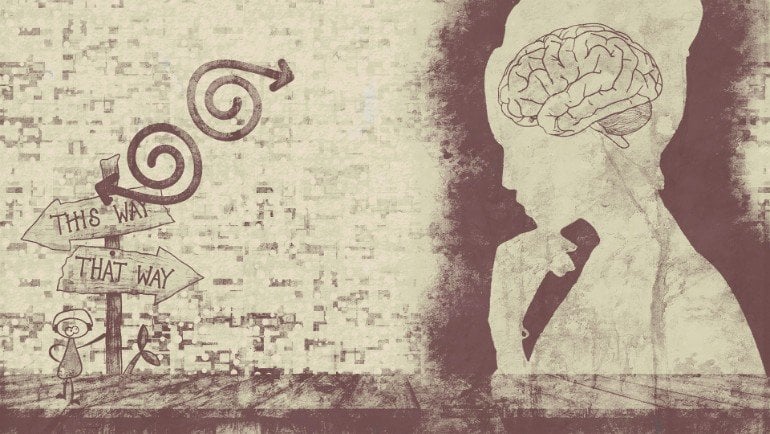Summary: If you want to conjure a new thought in your mind, you have to force yourself to stop ruminating on old thoughts. The insight could help with the treatment of PTSD and other disorders associated with rumination.
Source: University of Colorado
“Let it go.” “Think about something else.” “Clear your head.”
In our attempts to de-clutter our busy minds and make room for new, often more productive thoughts, people tap an array of different approaches. Which works best, and how does each strategy distinctly impact the brain?
Researchers at the University of Colorado Boulder and the University of Texas have taken a first stab at answering this question, combining novel brain imaging with machine learning techniques to offer an unprecedented window into what happens in the brain when we try to stop thinking about something.
The findings, published this month in the journal Nature Communications, lend new insight into the basic building blocks of cognition and could inform new therapies for issues like post-traumatic stress disorder and obsessive compulsive disorder. They also provide clues on how to form better study habits or innovate at work.
“We found that if you really want a new idea to come into your mind, you need to deliberately force yourself to stop thinking about the old one,” said co-author Marie Banich, a professor of psychology and neuroscience at CU Boulder.
For the study, Banich teamed up with Jarrod Lewis-Peacock, a cognitive neuroscience at UT-Austin, to examine brain activity in 60 volunteers as they tried to flush a thought from their working memory.
As Lewis-Peacock describes it, working memory is the “scratch pad” of the mind where we store thoughts temporarily to help us carry out tasks. But we can only keep three or four thoughts in working memory at a time. Like a sink full of dirty dishes, it must be cleaned out to make new ideas possible.
“Once we’re done using that information to answer an email or address some problem, we need to let it go so it doesn’t clog up our mental resources to do the next thing,” he said.
When we ruminate over something – perhaps the fight we had with a friend or an offending text — that can color new thoughts in a negative light. Such rumination is at the root of many mental health disorders, said Banich.
“In obsessive compulsive disorder it could be the thought of as, ‘If I don’t wash my hands again I will get sick.’ In anxiety, it might be, ‘This plane is going to crash.'” To determine if people can truly purge a thought, and how, the team asked each volunteer to lay down inside a functional magnetic resonance imaging machine (fMRI) at the Intermountain Neuroimaging Center on the Boulder campus.
They were shown pictures of faces, fruits and scenes and asked to maintain the thought of them for 4 seconds. Meanwhile, researchers created individualized ‘brain signatures’ showing precisely what each person’s brain looked like when they thought of each picture.
Afterward, participants were told to: replace the thought (“replace apple with mountain”); clear all thoughts (akin to mindfulness meditation); or suppress the thought (focus on it and then deliberately try to stop thinking about it). In each case, the brain signature associated with the image visibly faded.
“We were thrilled,” said Banich. “This is the first study to move beyond just asking someone, ‘Did you stop thinking about that?’ Rather, you can actually look at a person’s brain activity, see the pattern of the thought and then watch it fade as they remove it.”
The researchers also found that “replace,” “clear” and “suppress” had very different impacts.
While ‘replace’ and ‘clear’ prompted the brain signature of the image to fade faster, it didn’t fade completely, leaving a shadow in the background as new thoughts were introduced. ‘Suppress,’ on the other hand, took longer to prompt forgetting but was more complete in making room for a new thought.
Behavioral studies outside the scanner yielded similar results.
“The bottom line is: If you want to get something out of your mind quickly use ‘clear’ or ‘replace,'” said Banich. “But if you want to get something out of your mind so you can put in new information, ‘suppress’ works best.”
More research is necessary, but the findings suggest that students may want to pack up their algebra notes, take a break and deliberately try not to think about quadratic equations before moving on to study for physics.

Hit a wall on that report at work? Let it go for a while.
“People often think, ‘If I think about this harder I am going to solve this problem.’ But work by clinicians suggests it can actually give you tunnel vision and keep you in a loop that is hard to get out of,” said Banich.
In a counseling setting, the findings suggest that to fully purge a problematic memory that keeps bubbling up, one might need to deliberately focus on it and then push it away.
Someday, the brain imaging technique could potentially be used during sessions as a sort of cognitive mirror to help people learn how to put destructive thoughts out of their minds.
Banich and Lewis-Peacock intend to study that next.
“If we can get a sense of what their brain should look like if they are successfully suppressing a thought, then we can navigate them to a more effective strategy for doing that,” said Lewis-Peacock. “It’s an exciting next step.”
About this psychology research news
Source: University of Colorado
Contact: Lisa Marshall – University of Colorado
Image: The image is in the public domain
Original Research: Open access.
“Changes to information in working memory depend on distinct removal operations” by Hyojeong Kim, Harry R. Smolker, Louisa L. Smith, Marie T. Banich & Jarrod A. Lewis-Peacock. Nature Communications
Abstract
Changes to information in working memory depend on distinct removal operations
Holding information in working memory is essential for cognition, but removing unwanted thoughts is equally important. Here we use multivariate pattern analyses of brain activity to demonstrate the successful manipulation and removal of information from working memory using different strategies including suppressing a specific thought, replacing a thought with a different one, and clearing the mind of all thought. These strategies are supported by distinct brain regions and have differential consequences for allowing new information to be encoded.






